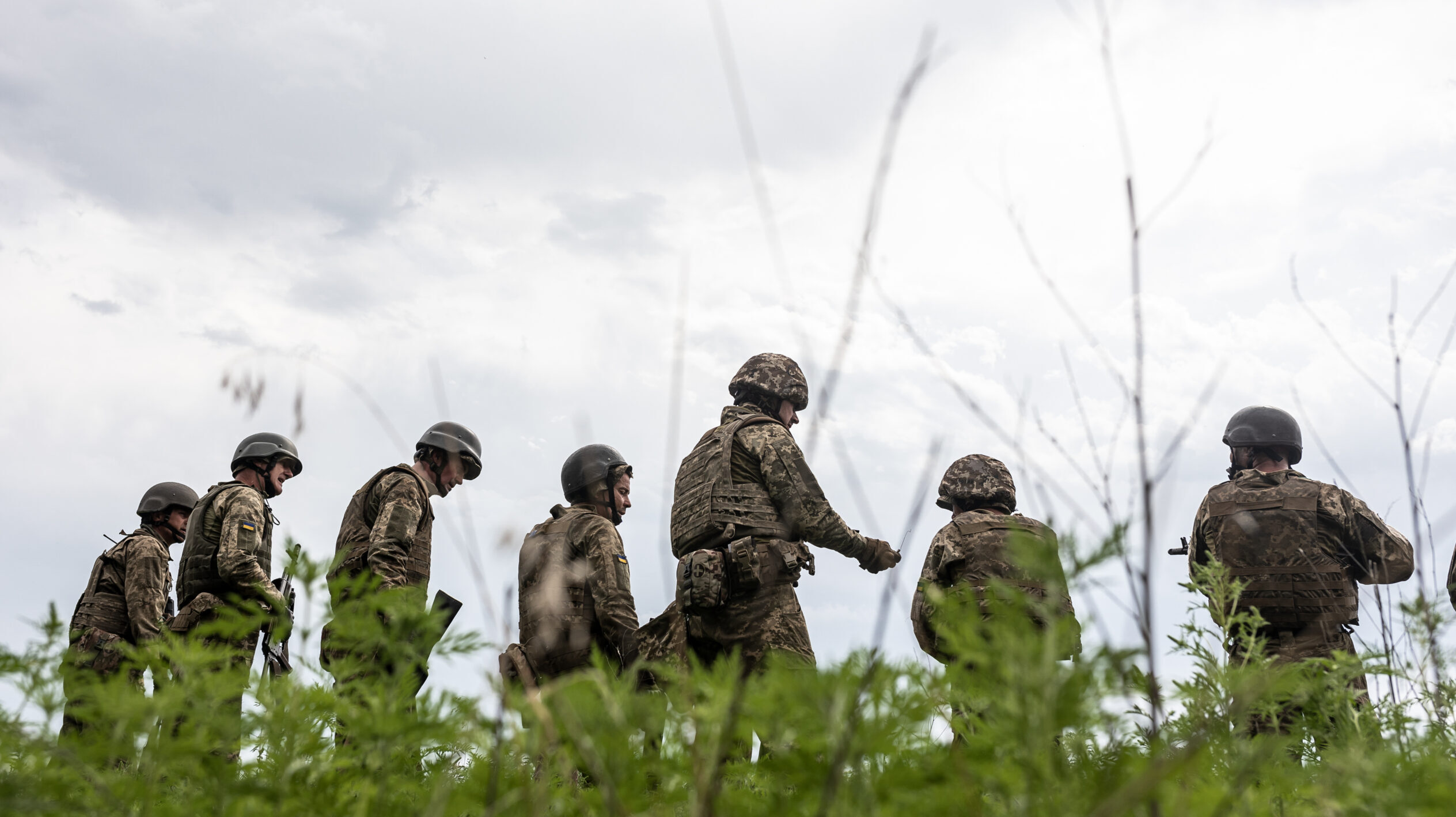
Ukrainian soldiers take infantry training in Donetsk Oblast as the Russia-Ukraine war continues in Ukraine, on August 11, 2023. (Diego Herrera Carcedo/Anadolu Agency via Getty Images)
FORT LAUDERDALE — With its counteroffensive seemingly stalled out, Ukraine over the last month stepped up its strikes inside Russian held territory — with a combination of weaponry that is symbolic of how Kyiv has fought its conflict since Russia’s February 2022 invasion.
On Aug. 23, Ukraine launched a strike deep into the territory of Crimea by a “new, completely modern” missile of Ukrainian design, destroying a Russian S-400 “Triumf” air and missile defense system — Russia’s most advanced defensive capability.
The day after the destruction of the S-400, Ukrainian special operations forces belonging to the Ukrainian Ministry of Defence’s Main Intelligence Directorate (GUR), supported by the Ukrainian Navy landed on the west coast of Crimea near the settlements of Olenivka and Mayak. GUR’s Telegram channel reported that “special units on watercraft landed on the shore” before engaging Russian troops stationed in the area with the Ukraine units reporting having suffered no losses.
It’s no surprise Ukraine would try to trumpet these victories, coming as they do near the Aug. 24 Ukraine Independence Day, which is now only behind Christmas and Easter as a national day of celebration. But they also speak to how Ukraine is trying to disrupt Russia away from the front lines — with a mix of long-range strikes and special operators willing to go deep in enemy territory. And in both cases, home-grown, or at least home-repurposed, weapons are playing an outsize role.
Repurposing and Modifying
At a price of over $600 million per unit, the S-400 is one of the most expensive air defense systems in Russia’s inventory. It had been deployed in Crimea since 2016 to control air space over the entire western half of the Black Sea.
In contrast, the S-360 Neptune missile designed by the Luch State Design Bureau in Kyiv cost a fraction of this sum — even with the low rate of production before the February 2022 invasion. The same missile sank the Moskva battle cruiser that had been the Russian Black Sea Fleet’s flagship in April 2022, and reportedly was the missile that destroyed the S-400.
According to Secretary of the National Security and Defense Council Oleksiy Danilov, the Neptune preformed “flawlessly” during the Aug. 23 attack on a Russian Almaz-Antei S-400 “Triumf” air and missile defense complex. This Russian missile defense system was located at Cape Tarkhankut in the northwest region of the Crimean peninsula that juts into the Black Sea.
The S-400 was protected by a short range air defense (SHORAD) KBP Tula Pantsir-S1/2 (SA-22) that was supposed to have been datalinked to the S-400’s radar. However, both the S-400 and Pantsir radars appear to have failed to detect the Neptune, and the SHORAD system was not able to bring it down. This mirrors an episode from earlier this summer when a Pantsir was unable to bring down MBDA Storm Shadow missiles even at point blank range. Moscow has lost at least 18 Pantsir units since the beginning of the war, per open source tracking.
The Neptune was first designed as an anti-ship missile, but Luch added in a GPS guidance capacity to supplement its seeker, which was designed by Radionix in Kyiv, one of the most capable defense electronics firms in Ukrainian industry. This gave the missile the flexibility to be re-purposed as a land-attack weapon.
A senior Ukrainian designer, briefed on the Aug. 23 attack, told Breaking Defense that “the seeker was switched into the passive mode for this strike. There were also modifications made to incorporate digital scene matching into the guidance system.” This is a similar capability to targeting technology on-board the MBDA Storm Shadow/SCALP-EG and the Lockheed Martin JASSM missiles — once in terminal phase, the imaging mode of the seeker compares the target area with pre-loaded digital scenery and continues on to target if the two are consistent with one another.
Of course, Neptune isn’t alone. Ukraine has been repurposing missile systems and other platforms since the beginning of the war. Several strikes on targets deep behind Russian lines have utilized a modified version of the S-200 (SA-5) surface-to-air missile, designated 5V28 or V-860/880 in this configuration — a weapon, like much of Ukraine’s legacy arsenal, originally designed for the Russian military.
According to the Ukrainian design bureau that developed these modifications, the first example of this missile being used for this mission was the August 2022 attack on the Novofedorivka airbase near Saki in Crimea. In early July a similarly modified S-200 struck an industrial site in Bryansk, 110 miles inside of Russia. Three weeks later the same type of missile almost hit a Russian bomber base in Taganrog.
Russian air defense forces claim to have foiled attacks using the same S-200-based missile, to include an attempt to inflict additional damage on the Kerch bridge linking Crimea with the Russian mainland. However, missile analysts have noted that for all these intercept claims by Moscow there is curious lack of footage to this effect.
The benefit for the Ukraine military is that the S-200 is basically a free weapons: it retired several hundred S-200s from service a decade ago, leaving Kyiv with an arsenal in excess of the Russian air defense forces’ ability to intercept them.
Then there are the closer-in strikes. One of the biggest trends to come from the Ukraine conflict is how both sides have used drones. Ukraine has seen particular success in hotwiring, repurposing or developing new systems, and those now appear to be in play behind enemy lines.
One day before the attack on the S-400 battery, a Ukrainian helicopter drone destroyed a Russian Aerospace Forces’ (VKS) Tupolev Tu-22M3 Backfire bomber at the Soltsy-2 aerodrome near St. Petersburg in the north of Russia. About a week later, Ukrainian drones hit six regions deep inside of Russia, including the aerodrome at Pskov near the border with Estonia and another military airfield at Kursk, which is south of Moscow and west of the regional capital of Voronezh.
Both attacks are notable for their level of destruction. The drones that hit Pskov are reported to have destroyed another Tu-22M3, at least two Ilyushin Il-76 military cargo lifters and also damaged two others. At Kursk, a Mikoyan MiG-29 and four Sukhoi Su-30SM fighter aircraft were put out of action.
But they are also notable for how they were launched, with a shockingly candid statement from a top Ukrainian official that forces are launching these strikes from within Russian-held territory.
“We are working from the territory of Russia,” Gen. Kyrylo Budanov, the head of the GRU, told media outlets at the end of August. According to an interview the enigmatic intelligence chief gave the Ukraine Independent Information Agency, his service intends increasingly destructive strikes on Russia. “War should be taken to the enemy’s territory, and for us, that’s Russia. The more the better,” he said.
Russian Challenges
The strikes also underline a series of challenges facing Russia’s defense of its own territory, even as it is largely having success — much to the disappointment of Ukraine’s supporters abroad — holding the line against Ukraine’s much-ballyhooed summer counteroffensive.
One is that there are simply not enough current-day air defense assets in Russia to cope with the strikes launched by the Ukrainian military, as well as the increasing ranges of the drones and missiles employed. The Pskov aerodrome should have been a high-priority for the air defense forces; that it was protected only by an older-generation ZSU-23-4 Shilka battery, a weapon initially used in the Vietnam era, is a sign of how thinly stretched Russia’s modern air defense systems are.
Secondly, datalinking the latest-generation SHORAD Pantsir-S1/2 (SA-22) vehicles to the radar command post of longer-range systems like the S-400 in Crimea have proven to be ineffective. The Pantsir was supposed to take out low-flying targets, but it not only missed the Neptune missile, but also failed to even shoot down the Ukraine drone that videoed the entire incident.
Thirdly, Russia’s drone costs per unit appear to be higher than what Ukraine is able to put in the field. For instance, a so-called “carboard” (actually wax-covered foamboard) Corvo drone manufactured by SYPAQ in Australia was responsible for the strike on the aircraft destroyed at the Kursk air base. These models cost around $3,000 apiece and weigh less than seven pounds, but they are destroying aircraft that weigh tons and cost in the millions.
In contrast, Russia has been trying to establish parity in the drone wars by building its own production line for the Iranian-made Shaheed attack UAVs (which cost $20,000 or more) at Alabuga in Tartarstan. However, a report by the Washington Post has outlined a number of key challenges facing the effort.
Among them: To keep key personnel tethered to the factory, Moscow’s FSB confiscated their passports so they could not leave Russia. Finding enough qualified production workers has proven elusive. At one point the factory management realized they did not have a forklift truck to unload disassembled, crated drones sent from Iran. Once one was located it was determined none of the personnel on hand were qualified to operate it.
In the longer term, Russia faces a deeper problem in that its production lines for these strategic platforms like the Il-76 and Tu-22M3 shut down decades ago. Consequently, there are very few possibilities to manufacture replacements for the aircraft lost in this war.
Ukrainian defense officials that previously had interaction with the Russian enterprises that make vital radar systems, electronic warfare pods and avionics tell Breaking Defense many critical specialists and engineers have left Russia, and claim that the factories cannot import enough components to support wartime-tempo production.
TAI exec claims 20 Turkish KAAN fighters to be delivered in 2028
Temel Kotil, TAI’s general manager, claimed that the domestically-produced Turkish jet will outperform the F-35 Joint Strike Fighter.


























